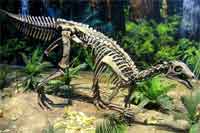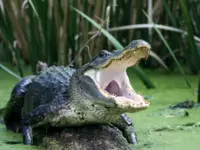 Popular media educated the public about the existence of dinosaurs.
Popular media educated the public about the existence of dinosaurs.
You may know a thing or two about these creatures from watching movies such as “The Land Before Time” or “Jurassic Park”. However, among these strange creatures are even more bizarre species that you’re probably not aware of. Here are five of the weirdest dinosaurs ever discovered.
Deinocheirus mirificus
Deinocheirus remained an enigma since its discovery in Mongolia in 1965. It is a strange-looking dinosaur having both Ornithomimosaur (ostrich dinosaurs) and non-ornithomimosaur features. Recent discoveries renewed interest in this mysterious creature. Scientists described new specimens, which shows that it is the largest member of the ostrich dinosaurs. Ornithomimosaurs normally have small to medium build, making Deinocheirus, the “Big Bird” of its kind. It has an elongated skull, duck-like bill and deep lower jaws, suggesting that it probably had a huge tongue. It swallowed food like a vacuum, sucking on vegetation found at the bottom of streams, lakes and ponds. Unearthed stomach contents revealed fish remnants supporting the theory that it thrived in freshwater habitats. Long forearms and three-fingered claws were probably used for digging shrubbery. Mobility was probably limited and slow as evidenced by its wide hips, uneven leg bones and large feet. Other bizarre features are fused collarbones and tailbones.
Microraptor gui
One of the most bizarre fossil discoveries in this century is that of a four-winged dinosaur originating from Northeastern China. It is one of the smallest dinosaurs, fully grown at 40 cm long, weighing 1 kg that lived 120 million years ago. When it was discovered, its skeletal remnants were nearly complete. What scientists find bizarre about this dinosaur is that its front and back limbs are covered with long feathers. Its feathers are heavily anchored to its body, similar to modern birds. Its wing pattern on front and back limbs is alike suggesting that this animal glided and thrived in trees. The unusual wing and feather features of Microraptors sparked interest among paleontologists. It became controversial if it has ability to fly. Microraptor gui provides probable evolutionary evidence that birds are descendants of dinosaurs. Aside from these, well-preserved stomach remnants consisting of birds and fish show that Microraptors hunt various microhabitats such as wetlands and arboreal areas for survival.
Nigersaurus taqueti
About 30 years ago, Nigesaurus was discovered among the Cretaceous rocks of Africa, South America and Europe. It has a built that is similar to that of an elephant, which spans about 9 meters in length. This is a relatively small frame for the family it belongs to, which are the Sauropods. It has a rectangular jaw that house 500 tiny teeth, comparable to that of a human toddler’s. Its mouth’s shape is so odd that scientists liken it to a lawn mower. A team of experts performed in-depth anatomical research on this creature, wherein skull CT scan reconstructions confirmed an elaborate dentition, that is stacked in a manner seemingly designed to replace overly used teeth. Despite the presence of a complex set of teeth, this dinosaur has a thin jaw bone suggesting that is has a weak bite. Experts conclude that this anatomic detail provides a clue that it fed on soft vegetation along waterways in the African continent.
Bonitasaura salgadoi
This dinosaur was discovered in 2004 in the Bonita Mountains of Patagonia, Argentina. It lived in the Late Cretaceous period, about 65 million years ago. It is approximately 30 feet long, weighed 18 metric tons. It is a Sauropod that is distinguished for its unusual mouth design. It has a broad, rectangular snout two differing sets of dentition.
It has sharp-pointed teeth in front and wedge-shaped dentition on the rear and middle parts of its mouth. Scientists determined that this evolutionary finding functions to grip crop vegetation by holding it within its teeth, using its beak to swallow mouthfuls of food. Compared to other dinosaurs in its family line, it has a relatively short neck with thick neural spines, suggesting that it had strong neck muscles. Because of these findings, Bonitasaura is presumed to have a strong bite and despite its short neck, it still fed on high slopes of trees, which brought about its well-developed neck musculature.
Therizinosaurus
Therizinosaurs are gigantic lizards that lived in the Late Cretaceous period. Some of its remnants were discovered in Mongolia and were originally thought to belong to a new turtle-like reptile. What made Therizinosaurus bizarre is its unusually large, elongated claws sticking out from its fingers. Claws are so huge that it grows up to 1 meter long. Paleontologists thought that this unique anatomy was used for defense while combatting against predatory dinosaurs. It was also thought to be a symbol of reproductive maturity among the dinosaur clan. On the practical side, these claws probably have evolved as a dietary adaptation to reach out for food from tall trees. Scientists thought that among its family clan, Therizinosaurus were probably very selective of its food. However, definitive data to support its feeding habits is still lacking because its complete skeletal anatomy has yet to be discovered.












Leave a Reply